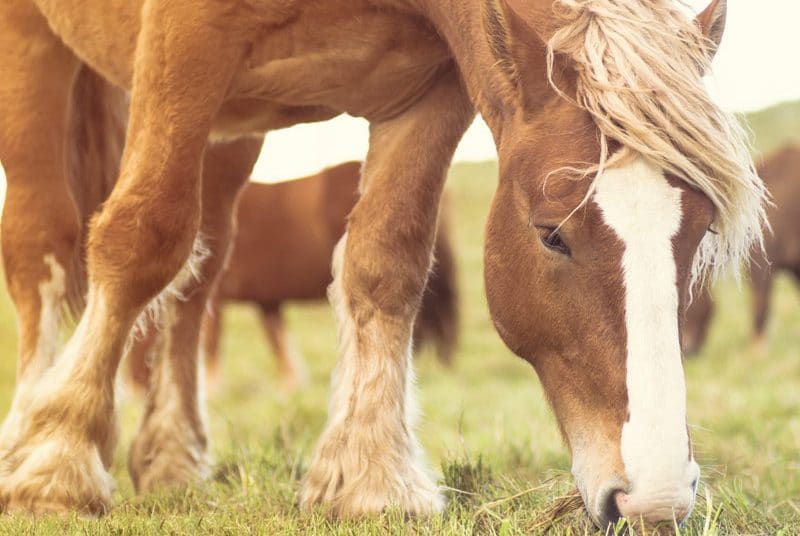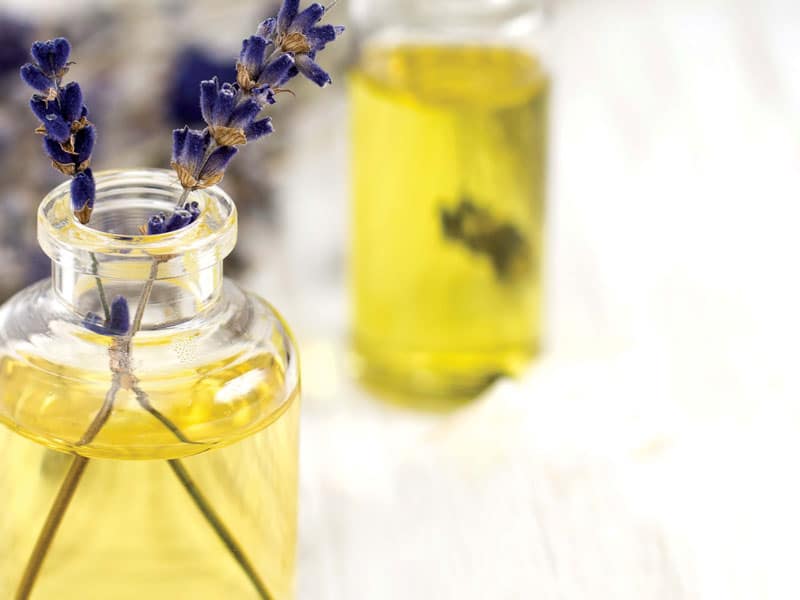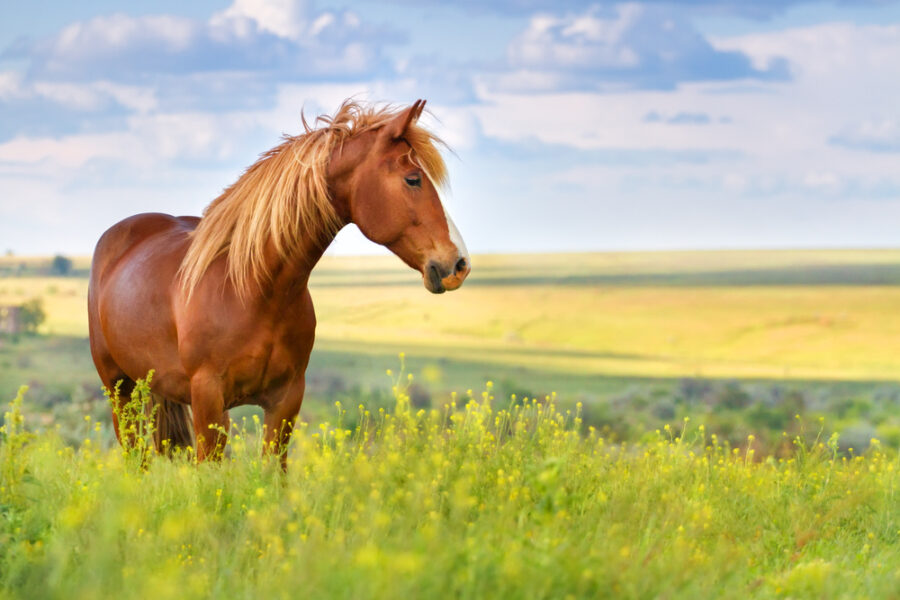Whether an equine has a simple cough, or a serious chronic disease of which the cough is a symptom, certain herbs can help either cure or alleviate the problem.
The equine cough may be a simple symptom to deal with — or it may reflect deep and entrenched chronic disease. A horse can develop a simple cough in response to an invading pathogen (i.e. bacteria, virus, fungi, dust), but is very susceptible to retaining that pathogenic material. This can result in severe and complicated chronic disease, of which the cough is a symptom, such as chronic obstructive pulmonary disease (COPD). Either way, easily-obtained herbal medicines can either cure a horse’s cough, or help alleviate the symptom as part of a more complex treatment plan. This article will focus on the principle or leading herbs that can give symptom relief from an equine cough.
Considerations when using herbs for a cough in horses
- In general, the main leading herb will have the highest proportion in a formula, with the assisting herbs present in a lower percentage. A typical formula would address the specific energetics of the individual horse (see sidebar on page xx), with an expectorant, antispasmodic effect to relax the spasms of the cough.
- The approach utilized by some Western herbalists is to use herbs based on their pharmacologic effects – that is, expectorant, anti-spasmodic, diaphoretic, or mucolytic. This approach is effective, but the practitioner still needs to pay attention to the temperature effects of the herb. Cold herbs must be balanced with a warming herb if the horse is cold. Likewise, if the animal is showing signs of a heat excess, one must use great caution with hot or warming herbs.
- A quick note about dosing: in general, an adult 1,000-pound horse requires only two to three times the human dose of a formula, usually 1-2 tbsp of a ground dried herb, or 80 drops of a tincture. Most horses love the taste of herbs and readily eat them in a bran mash. They can also be mixed with some applesauce. In an acute critical situation, higher doses, such as triple the regular dose, are often needed in the short term. Care must be taken with any drop dose herbs when formulating a prescription. In other words, botanical medicines are powerful and should never be used without a firm foundation of knowledge.
Is the horse’s cough wet or dry?
The first differentiation is if the cough is wet or dry. A wet cough sounds heavy and rattly. The horse is expectorating mucus and is seen to be swallowing after coughing. The tongue is wet, probably swollen, with teeth imprints on its edge. The pulse could be full and “slippery”. A dry cough, conversely, would be deep and harsh. There is no excessive moisture in the mouth, and the tongue would be dry, often with cracks. If heat is present, the pulse will be fast; if the animal is more “cold”, the pulse will be deep and slow. A dry disease state has a dry tongue, while a wet disease would have a wet tongue.
Herbs for the dry cough
From a Western pharmacological view, if the cough is dry, one would look for herbal medicines with expectorate, mucolytic, and mucus membrane protectant effects. While the horse’s tongue would be dry, it could be either pale or red. If red, there is heat trapped in the body and a cooling herb is indicated. Conversely, if the tongue is pale, a more warming herb is indicated.
- Mullein leaf (Verbascum thapsus) is one of the most versatile herbs for dry coughs. It is slightly cool to neutral, so can be used in cold or hot conditions. Mullein is considered high in mineral salts and releases a salty mucilage, which is very helpful for dry coughs, especially when the horse is unable to expectorate “stuck phlegm”. This mucilage acts as an emollient to bring water into hardened, closed places, such as dried-out tissues, causing the release of secretions from those tissues.
Mullein is indicated when tissues are dry or when water is caught in isolated pockets. It is particularly useful for dry, irritable, tickly coughs. Mullein opens the lungs, reduces coughing and tightness, lubricates the mucosa, relaxes the larynx, opens the sinuses, and causes a more open feeling in the head and brain.
Mullein has a mild analgesic, antibacterial, anti-inflammatory, antispasmodic, and expectorant pharmacologic effect. It is a soothing expectorant useful for irritative coughs, upper respiratory tract congestion, and laryngitis. It can also be used as part of a formula for more severe respiratory illness, such as bronchitis and asthma. The fresh leaves decocted in milk were used in England and Ireland as a folk remedy for treating or preventing tuberculosis.
Mullein also has an influence on the nerves and mind. It is a great painkiller and helps induce sleep. Mullein has a calming effect on all inflamed and irritated nerves, which is why it works so well for controlling coughs, cramps, and spasms. It can loosen mucus and move it out of the body. Mullein is valuable for all lung problems because it nourishes as well as strengthens. This herb has a long history of use, as reported in the 1800’s: “Husbandmen of Kent do give it their cattle against the cough of the lungs.”
- Marshmallow root (Althaea officinalis) is another very effective botanical medicine for dry coughs. It has a long traditional use as an emollient, and is specific for hot, dry inflamed mucous membrane tissues in the throat.
- Horehound (Marrubium vulgar) has long been used as a respiratory remedy. Because it is energetically almost neutral, it can be used in hot or cold, dry or damp lung conditions. It is especially indicated for non-productive coughs with a feeling of constriction in the chest due to bronchitis or damp asthma. It can also be used for upper respiratory conditions, bronchiectasis (for enhancing fluid drainage), laryngitis, post-nasal drip, and pneumonia. Culpeper, a 1600s herbalist, stated that horehound is helpful for those who are short of breath, asthmatic, or have a cough, to clear cold “rheums” from the lungs of older people, and to expectorate tough phlegm from the chest.
Herbs for the wet cough
A wet cough is softer and moist, and a nasal discharge is seen. A white or clear nasal discharge is classified as cold, while a yellow or green discharge is classified as hot. A horse with a hot condition has a faster pulse with a reddish tongue; a cold pulse is slower.
The tongue of a damp horse would be swollen with lots of moisture in the mouth. The main herb needs to be warming and act as a stimulant to move and resolve the damp accumulation.
- Ginger (Zingiber officinale) can assist in treating a damp/cold cough. Dried ginger warms the center and expels cold, as it is a warming circulatory stimulant. It is also an expectorant for cold/damp lung conditions (profuse clear or white mucus). Ginger works synergistically with cinnamon, thyme, and/or citrus peel.
- Cinnamon (Gui zhi) is a diaphoretic and circulatory tonic. It is warm, dry, sweet and pungent, and is specific for wind/damp or wind/cold conditions.
- Thyme (Thymus vulgaris) is classified as antitussive, expectorant, alterative and immunoregulatory, with antimicrobial, antispasmodic, antioxidant, antiallergic, anti-inflammatory, and anti-catarrhal effects. It also acts as a carminative digestive tonic.
More about thyme
This herb has been used for thousands of years. “Thymos” means strength in Greek. Dioscorides, a Greek physician in the first century AD, stated that thyme “expels dampness, expels viscous phlegm from the chest and helps difficult breathing and wheezing; and expels ‘worms.’” It is suited for cold, inactive conditions, where there are chills, putrefaction, with stagnant stuck mucus. Hildegard von Bingen stated that thyme’s heat and strength carries off the putrid matter caused by ailments, and will diminish rotten matter and bad humors.
Thyme is a dry herb, with both a hot and warm-cool temperature. While it is very warming and stimulating, it does exert a slightly cooling effect as it moves blood, which means it can be used for horses with a sub-normal to slightly elevated temperature, though not those with high fevers. Thyme is an aromatic, acrid, and slightly bitter herb high in phenolic monoterpenoids with a strong antibacterial/antifungal effect. It is among the herbs that are very effective against mycoplasma infections. Thyme leaf stimulates immunity and has a broncholytic and secretomotor agent. It doubles the rate of ciliary clearance.
Eucalyptus leaf and citrus peel
Eucalyptus leaf (Eucalyptus globulus) leaf works synergistically with thyme. It has expectorant, antitussive, antimicrobial, antispasmodic, and antibacterial effects along with a bronchodilating sedative action. Eucalyptus leaf treats stagnant, depressed, and constricted tissue.
Citrus peel (Citrus aurantium) is a useful expectorant and flavoring agent in cough syrups. It is a warming antibacterial, and most effective for cold/damp coughs. Citrus peel also has the ability to decrease pathogenic biofilms. Biofilms can prevent the body’s immune system from fully expelling pathogenic material, thereby setting the stage for the development of deeper pathologic conditions.
Additional herbs for equine coughs
- When dealing with a “hot” condition, cooling to cold herbs with strong antimicrobial effects are needed. Honeysuckle, Jin Yin Hua (Lonicera japonica) is an analgesic, antibacterial, antifungal, anti-inflammatory, antioxidant, antiviral, diaphoretic, diuretic, expectorant febrifuge that clears blood heat, fire poison, pathogenic fire and/or wind/heat. In China, the barefoot doctors used a combination of Lonicera and Chinese Coptis as a pill. This antibiotic-like medicine was known as poor man’s penicillin.
- When a cough is the leading presenting symptom, anti-spasmodic (clear wind) herbs are of prime importance. Khella seed (Ammi visnaga) is cold, slightly drying, bitter, acrid, and dispersing. It is a leading respiratory spasmolytic, and can prevent bronchial asthma attacks. Khella seed calms liver wind, acting as an antispasmodic.
- Elecampane root (Inula helenium) is a superb respiratory remedy for ticklish, persistent coughs with pain in the ribs and chest.
- Wild cherry bark (Prunus virginiana, P. serotina) has a long history of use as a cough suppressant. It is specific for spasmodic hacking coughs with excess mucus and dyspnea. The Eclectics felt it was most effective for chronic respiratory irritation accompanied by a feeble but rapid pulse. The fresh bark, twigs, and leaves of the cherry tree contain cyanide; dry the bark thoroughly before using it.
Wild cherry bark preparation
Following is a preparation of wild cherry bark syrup from the 1890 7th U. S. Pharmacopoeia: “Wild Cherry, in No. 20 powder, one hundred and fifty grams; sugar, seven hundred grams; glycerin, one hundred and fifty cubic centimeters; water, a sufficient quantity to make one thousand cubic centimeters. Mix the glycerin with three hundred (300) cubic centimeters of water. Moisten the Wild Cherry with a sufficient quantity of the liquid, and macerate for 24 hours in a closed vessel; then pack it firmly in a cylindrical percolator and pour on the remainder of the menstruum. When the liquid has disappeared from the surface, follow it by water, until the percolate measures 450 cubic centimeters. Dissolve the sugar in the percolate by agitation, without heat, strain and pass enough water through the strainer to make the product measure 1,000 cubic centimeters. Mix thoroughly.”
- A final thought for a post Strep equi. infection cough that might be due to a deeper abscess: if this is suspected, one very useful herb to use in your formula is Japanese Knotweed root (Fallopia japonica). It is very high in resveratrol and specific for abscesses of internal organs and coughs with yellow phlegm.
These a just a few herbal medicines that can not only help resolve equine coughs but, more importantly, address the root cause of the cough. It is important to use sustainably grown herbs from reputable growers. For further information, contact United Plant Savers (unitedplantsavers.org) and the VBMA (vbma.org).
References
Bensky D, Barolet R. Chinese Herbal Medicine, Formulas & Strategies; United States; 1992.
Chen J and T, Beebe S, Salewski M. Chinese Herbal Formulas for Veterinarians; Art of Medical Press; City of Industry; 2012
Fruehauf, Heiner. Lecture on Gu Syndrome; Daoist Arts College, Oct 10, 2020.
Liu G. Warm Pathogen Diseases: Clinical Guide, Seattle, Eastland Press, 2005, pp 3-37, 261-263
Ni M. The Yellow Emperor’s Classic of Medicine, Boston, MA, Shambhala, 1995.
Winston, David. Two year Professional Herbal Class, 2018-2020.
Wood, Matthew. The Earthwise Herbal: A complete Guide to Old World Medicinal Plants, North Atlantic Books, 2008.






